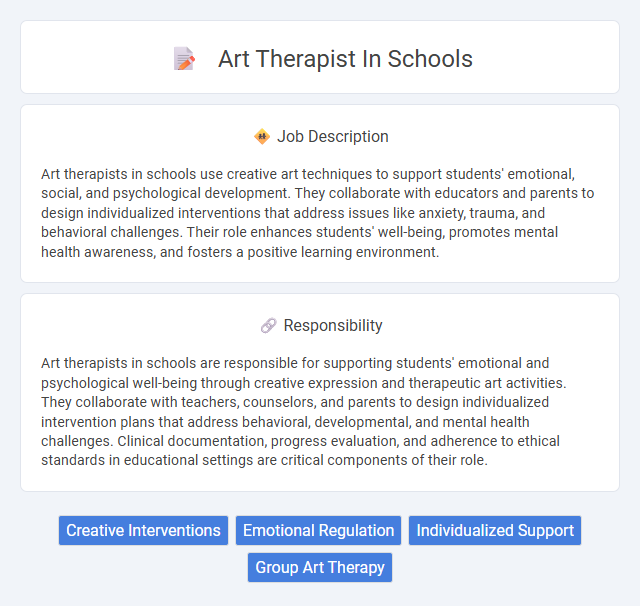
Art therapists in schools use creative art techniques to support students' emotional, social, and psychological development. They collaborate with educators and parents to design individualized interventions that address issues like anxiety, trauma, and behavioral challenges. Their role enhances students' well-being, promotes mental health awareness, and fosters a positive learning environment.
Individuals with strong empathy and a passion for helping children facing emotional or developmental challenges are likely well-suited for a school-based art therapist role. Those comfortable with creative expression and open to adapting therapeutic techniques to diverse student needs may find this job rewarding and effective. However, candidates who prefer structured, conventional therapy methods or have limited patience for evolving school environments might struggle in this position.
Qualification
Art therapists in schools typically require a master's degree in art therapy or a related mental health field, alongside state licensure or certification specific to art therapy. Strong knowledge of child development, counseling techniques, and educational psychology is essential to effectively support students' emotional and behavioral needs. Experience with diverse student populations and the ability to collaborate with educators and parents are critical qualifications for success in this role.
Responsibility
Art therapists in schools are responsible for supporting students' emotional and psychological well-being through creative expression and therapeutic art activities. They collaborate with teachers, counselors, and parents to design individualized intervention plans that address behavioral, developmental, and mental health challenges. Clinical documentation, progress evaluation, and adherence to ethical standards in educational settings are critical components of their role.
Benefit
Art therapists in schools likely provide significant benefits by supporting students' emotional and mental well-being through creative expression. Their interventions may enhance students' social skills, self-esteem, and academic performance by addressing underlying psychological challenges. Employing art therapists could contribute to a more inclusive and supportive educational environment, benefiting both individual students and the broader school community.
Challenge
Art therapists in schools likely face the challenge of addressing diverse student needs while adapting therapeutic approaches to fit various educational settings. Managing limited resources and time constraints could impact the effectiveness of their interventions. Balancing emotional support with academic demands may require flexibility and creative problem-solving skills.
Career Advancement
Art therapists in schools can advance their careers by pursuing specialized certifications, such as Registered Art Therapist (ATR) or Board Certified Art Therapist (ATR-BC), enhancing their credentials and expertise. Gaining experience in diverse educational settings and collaborating with multidisciplinary teams opens opportunities for leadership roles like program coordinator or supervisor. Pursuing advanced degrees in clinical or educational psychology further positions school art therapists for roles in research, policy development, or higher education teaching.
Key Terms
Creative Interventions
Art therapists in schools utilize creative interventions to support students' emotional and psychological well-being, employing techniques such as drawing, painting, and sculpture to facilitate self-expression. These creative interventions help address issues like anxiety, trauma, and behavioral challenges by providing a non-verbal outlet for processing complex emotions. Integrating art therapy into the educational environment promotes mental health, improves concentration, and enhances social skills among students.
Emotional Regulation
Art therapists in schools play a crucial role in supporting students' emotional regulation by using creative expression to help them identify and manage their feelings. Through guided art activities, these professionals facilitate self-awareness, stress reduction, and improved coping skills among diverse student populations. Their interventions promote mental well-being, enhance emotional resilience, and contribute to a positive learning environment.
Individualized Support
Art therapists in schools provide individualized support by tailoring creative interventions to meet each student's unique emotional and developmental needs. They utilize expressive art techniques to help students process trauma, manage anxiety, and improve social skills within a safe and supportive environment. This personalized approach fosters emotional resilience and academic engagement, promoting overall mental well-being in the school setting.
Group Art Therapy
Group art therapy in schools facilitates emotional expression and social skills development among students through creative activities. Art therapists design structured sessions that encourage collaboration, empathy, and self-awareness, aiding in the management of anxiety, trauma, and behavioral issues. Evidence shows this therapeutic approach improves student mental health and promotes a positive school environment.
 kuljobs.com
kuljobs.com